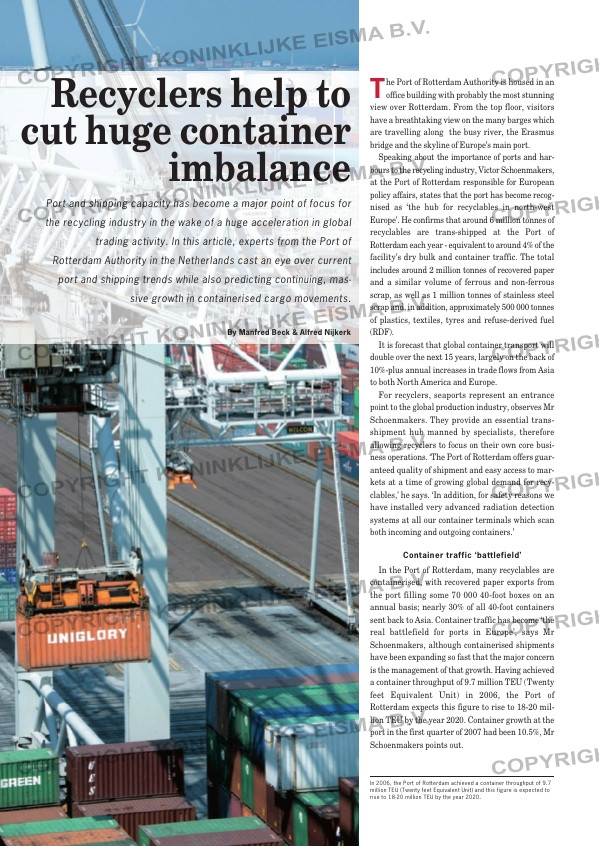Page 52 from: November 2007

Recyclers help to
cut huge container
imbalance
Port and shipping capacity has become a major point of focus for
the recycling industry in the wake of a huge acceleration in global
trading activity. In this article, experts from the Port of
Rotterdam Authority in the Netherlands cast an eye over current
port and shipping trends while also predicting continuing, mas-
sive growth in containerised cargo movements.
In 2006, the Port of Rotterdam achieved a container throughput of 9.7
million TEU (Twenty feet Equivalent Unit) and this figure is expected to
rise to 18-20 million TEU by the year 2020.
By Manfred Beck & Alfred Nijkerk
The Port of Rotterdam Authority is housed in anoffice building with probably the most stunning
view over Rotterdam. From the top floor, visitors
have a breathtaking view on the many barges which
are travelling along the busy river, the Erasmus
bridge and the skyline of Europe’s main port.
Speaking about the importance of ports and har-
bours to the recycling industry, Victor Schoenmakers,
at the Port of Rotterdam responsible for European
policy affairs, states that the port has become recog-
nised as ‘the hub for recyclables in north-west
Europe’. He confirms that around 6 million tonnes of
recyclables are trans-shipped at the Port of
Rotterdam each year – equivalent to around 4% of the
facility’s dry bulk and container traffic. The total
includes around 2 million tonnes of recovered paper
and a similar volume of ferrous and non-ferrous
scrap, as well as 1 million tonnes of stainless steel
scrap and, in addition, approximately 500 000 tonnes
of plastics, textiles, tyres and refuse-derived fuel
(RDF).
It is forecast that global container transport will
double over the next 15 years, largely on the back of
10%-plus annual increases in trade flows from Asia
to both North America and Europe.
For recyclers, seaports represent an entrance
point to the global production industry, observes Mr
Schoenmakers. They provide an essential trans-
shipment hub manned by specialists, therefore
allowing recyclers to focus on their own core busi-
ness operations. ‘The Port of Rotterdam offers guar-
anteed quality of shipment and easy access to mar-
kets at a time of growing global demand for recy-
clables,’ he says. ‘In addition, for safety reasons we
have installed very advanced radiation detection
systems at all our container terminals which scan
both incoming and outgoing containers.’
Container traffic ‘battlefield’
In the Port of Rotterdam, many recyclables are
containerised, with recovered paper exports from
the port filling some 70 000 40-foot boxes on an
annual basis; nearly 30% of all 40-foot containers
sent back to Asia. Container traffic has become ‘the
real battlefield for ports in Europe’, says Mr
Schoenmakers, although containerised shipments
have been expanding so fast that the major concern
is the management of that growth. Having achieved
a container throughput of 9.7 million TEU (Twenty
feet Equivalent Unit) in 2006, the Port of
Rotterdam expects this figure to rise to 18-20 mil-
lion TEU by the year 2020. Container growth at the
port in the first quarter of 2007 had been 10.5%, Mr
Schoenmakers points out.
RI_015 Rotterdam:Opmaak 1 08-11-2007 09:44 Pagina 52



